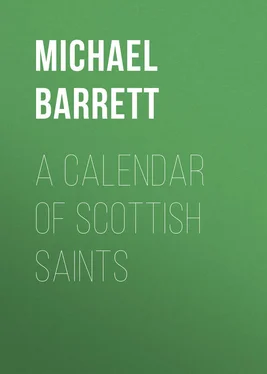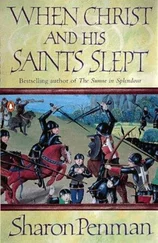Michael Barrett - A Calendar of Scottish Saints
Здесь есть возможность читать онлайн «Michael Barrett - A Calendar of Scottish Saints» — ознакомительный отрывок электронной книги совершенно бесплатно, а после прочтения отрывка купить полную версию. В некоторых случаях можно слушать аудио, скачать через торрент в формате fb2 и присутствует краткое содержание. Жанр: foreign_antique, foreign_prose, на английском языке. Описание произведения, (предисловие) а так же отзывы посетителей доступны на портале библиотеки ЛибКат.
- Название:A Calendar of Scottish Saints
- Автор:
- Жанр:
- Год:неизвестен
- ISBN:нет данных
- Рейтинг книги:5 / 5. Голосов: 1
-
Избранное:Добавить в избранное
- Отзывы:
-
Ваша оценка:
- 100
- 1
- 2
- 3
- 4
- 5
A Calendar of Scottish Saints: краткое содержание, описание и аннотация
Предлагаем к чтению аннотацию, описание, краткое содержание или предисловие (зависит от того, что написал сам автор книги «A Calendar of Scottish Saints»). Если вы не нашли необходимую информацию о книге — напишите в комментариях, мы постараемся отыскать её.
A Calendar of Scottish Saints — читать онлайн ознакомительный отрывок
Ниже представлен текст книги, разбитый по страницам. Система сохранения места последней прочитанной страницы, позволяет с удобством читать онлайн бесплатно книгу «A Calendar of Scottish Saints», без необходимости каждый раз заново искать на чём Вы остановились. Поставьте закладку, и сможете в любой момент перейти на страницу, на которой закончили чтение.
Интервал:
Закладка:
St. Cadroe, Abbot, A.D. 937.
He was connected with the royal family of Strathclyde. In his youth he was sent to Ireland to be educated at Armagh. Returning to Scotland, he devoted himself to the training and education of youths for the priesthood.
Later on he gave himself to a life of pilgrimage and passed into England, where Odo, Arch bishop of Canterbury, received him with great kindness; he also visited the King, Edmund, at Winchester. Crossing over to France, Cadroe, by the direction of St. Fursey, who appeared to him in a vision during prayer, took the monastic habit at the Benedictine Abbey of Fleury. But although he wished to remain there as a simple monk, his sanctity caused him to be made abbot of the monastery of Wassons-on-the Meuse, which he ruled for some years. At the request of the Bishop of Metz he took up his residence in that city in the Abbey of St. Clement, where he instituted a thorough reform of discipline. He remained at the latter monastery till his death at the age of seventy, which was followed by many miracles.
8 – St. Duthac, Bishop, A.D. 1068.
This saint was of Scottish birth, but was educated, like many of his contemporaries, in Ireland. Returning to his native land, he was consecrated bishop, and devoted himself with zeal to the pastoral office. He is said to have especially shown this devotion in hearing the confessions of his people. He laboured as bishop in the districts of Moray and Ross. Both during life and after death he was noted for many miracles. He was buried in the church of Tain, whose Gaelic title is Baile Dhuich (Duthac's Town). Seven years after death his body was found incorrupt, and was removed to a more honourable shrine in the same church. His resting-place became one of the chief places of pilgrimage in the country. James IV. visited it no less than three times, travelling thither with a large retinue. At that date St. Duthac's Bell was treasured at Tain. St. Duthac is patron of Kilduich, at the head of Loch Duich in Kintail. The saint probably visited this spot, which belonged to his pastoral charge. Kilduthie, near the Loch of Leys, Kincardineshire, and Arduthie, near Stonehaven, in the same county, both take their names from this saint. A chapel in the Benedictine Abbey of Arbroath bore the dedication of St. Duthac. Two fairs called after him were held annually at Tain – "St. Duthac in Lent" was on his feast-day; that in December probably indicated some translation of his relics. At Tain is St. Duthac's Cairn. A holy well bears his name in the parish of Cromarty. Leo XIII restored his feast in 1898.
10 – St. Failhbe (the second), Abbot, A.D. 745.
This saint was one of the abbots of Iona. He ruled that monastery for seven years, and died there at the age of seventy.
St. Kessog or Mackessog, Bishop and Martyr, A.D. 560.
He was a native of Ireland, but devoted himself to missionary labours in Scotland, in the province of Lennox. He used as his retreat Innis a' Mhanaich (Monk's Island) in Loch Lomond. Tradition says that he suffered martyrdom near Luss, in Dumbartonshire. Another version is that being martyred in a foreign country, and his body being conveyed to Scotland for burial, the herbs with which it was surrounded took root and grew where he was laid to rest; hence the name Luss (herbs) was given to the spot, and was afterwards extended to the parish. The place of his burial is called "Carnmacheasaig." The church of Luss had the privilege of sanctuary, which extended for three miles round it, so that no one could be molested within that boundary for any cause; this was granted by King Robert Bruce in 1313. The church of Auchterarder, Perthshire, was dedicated to this saint, and he was also venerated at Callander; at both places, as also at Comrie, Perthshire, fairs were held annually on his feast-day. Near Callander is a conical mound bearing his name. The bell of the saint was preserved up to the seventeenth century. At Inverness is "Kessog Ferry." The saint's name was often used by the Scots as a battle-cry, and he is sometimes represented as the patron of soldiers, wearing a kind of military dress.
11 – St. Constantine, King and Martyr, A.D. 590.
This saint was a British king who reigned in Cornwall. His early life was stained by many crimes, but, becoming converted to piety, after his wife's death he entered the monastery of Menevia, now known as St. David's, that he might expiate his sins by penance. St. Kentigern, then an exile in that same monastery, exhorted him to devote himself to preaching the Faith in Cumbria. St. Constantine accordingly founded a monastery at Govan, in Lanarkshire, where he became abbot, and from whence he and his disciples preached Christianity to the people of the surrounding country. He converted the people of Cantyre, and met his death in that district at the hands of the enemies of his teaching. He was buried at Govan, where the church bears his name. Kilchousland in Cantyre takes its name from him. The ancient church of Kinnoul, near Perth, and that of Dunnichen, Forfarshire, were also dedicated to this saint; at the latter place was St. Cousland's (or Causnan's) Fair, and some remains of St. Cousland's chapel are there still. The water of his well at Garrabost, in Lewis, known as St. Cowstan's, is said never to boil any kind of meat, however long it may be kept over a fire. The feast of this saint was restored by Leo XIII.
St. Libranus, Abbot.
He was one of the many saintly abbots of Iona.
12 – St. Indrecht, Abbot and Martyr, A.D. 854.
This saint was also Abbot of Iona, being the twenty-first in order of succession. On his way to Rome he was martyred by the Saxons.
St. Fechno, or Fiachna, Confessor, A.D. 580.
He was one of the twelve disciples who accompanied St. Columba to Scotland. He was probably born in the north of Ireland, and spent some years under St. Columba's rule. Miracles are said to have been wrought at his tomb.
16 – St. Finan, Abbot, A.D. (about) 575.
Конец ознакомительного фрагмента.
Текст предоставлен ООО «ЛитРес».
Прочитайте эту книгу целиком, купив полную легальную версию на ЛитРес.
Безопасно оплатить книгу можно банковской картой Visa, MasterCard, Maestro, со счета мобильного телефона, с платежного терминала, в салоне МТС или Связной, через PayPal, WebMoney, Яндекс.Деньги, QIWI Кошелек, бонусными картами или другим удобным Вам способом.
Интервал:
Закладка:
Похожие книги на «A Calendar of Scottish Saints»
Представляем Вашему вниманию похожие книги на «A Calendar of Scottish Saints» списком для выбора. Мы отобрали схожую по названию и смыслу литературу в надежде предоставить читателям больше вариантов отыскать новые, интересные, ещё непрочитанные произведения.
Обсуждение, отзывы о книге «A Calendar of Scottish Saints» и просто собственные мнения читателей. Оставьте ваши комментарии, напишите, что Вы думаете о произведении, его смысле или главных героях. Укажите что конкретно понравилось, а что нет, и почему Вы так считаете.












